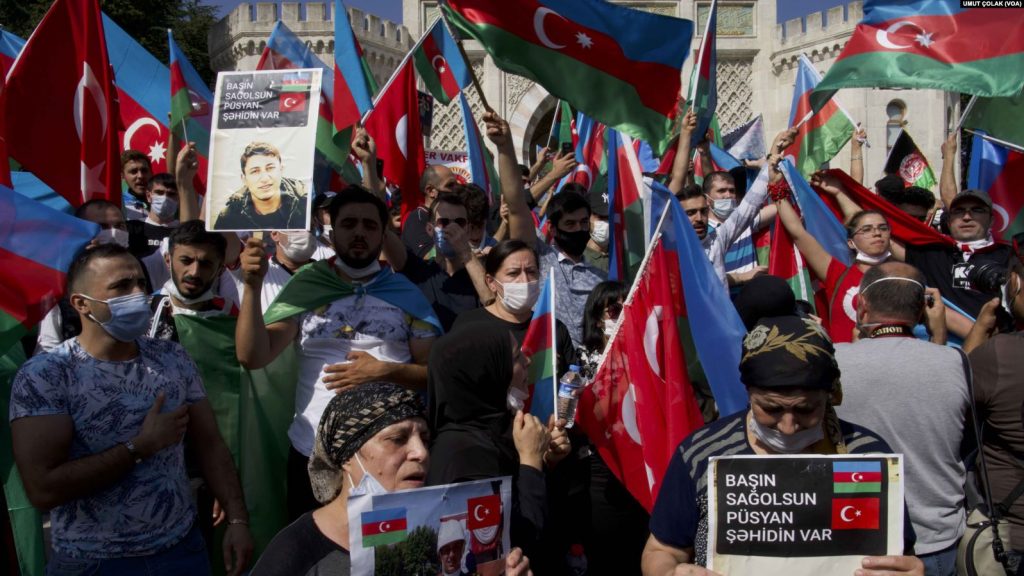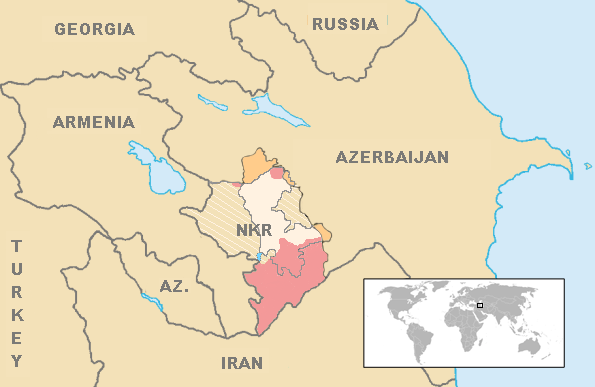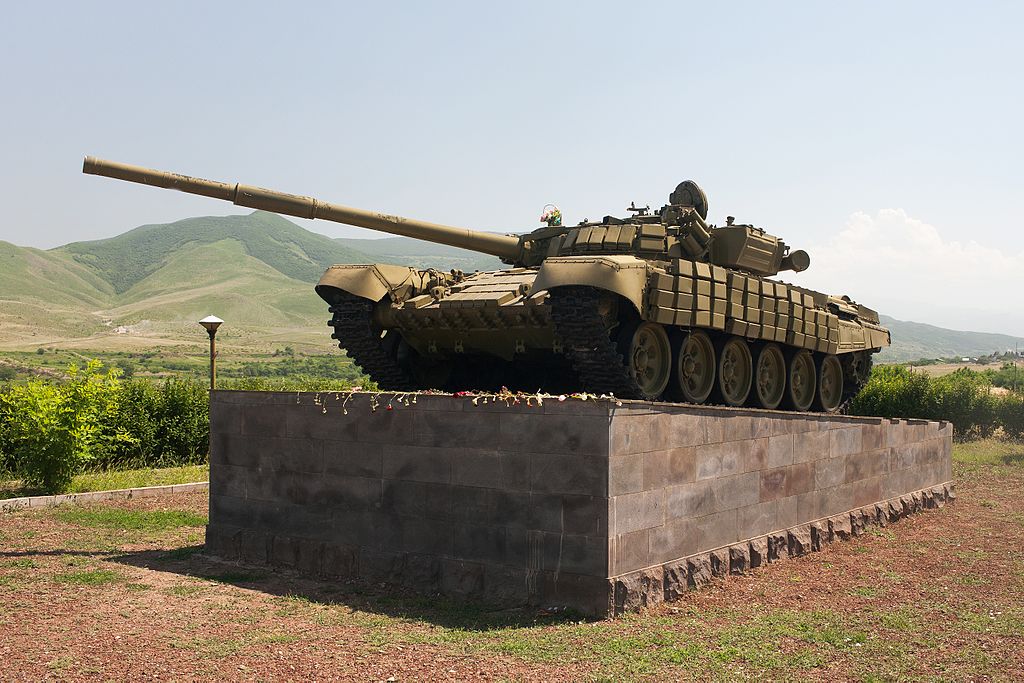Fault lines of a war foretold
Despite the ceasefire, Nagorny Karabakh’s status remains unclear. Any lasting solution must deal with the anxieties of precarious nations and unachieved statehood. On the historical roots of the long-standing conflict and the legal ambiguities of a war in contested territory.
In the early hours on 10 November 2020, news broke that a Russian-mediated ceasefire agreement between Armenia and Azerbaijan had been reached overnight, halting the large-scale military confrontation that had erupted on 27 September along the Nagorny Karabakh Line of Contact. Although it was the fourth ceasefire negotiated within a few weeks, there is reason to believe that it will be more stable than its predecessors. Azerbaijan has achieved a major victory by capturing territories and settlements around and within Nagorny Karabakh; the outgunned Armenian forces in the enclave have been spared imminent collapse; and Russian troops have already been dispatched to the region as peacekeepers.
On the face of it, Azerbaijanis and Armenians have once more fought over this mountainous stretch of land deep in the South Caucasus, agreeing on yet another ceasefire to temporarily arrest the long-standing conflict between the two states. Yet, on closer inspection, there are a variety of actors and factors that render the picture much more complex.
The war over Nagorny Karabakh must be understood against the backdrop of three historical forces that have left the region’s status fundamentally contested: the twentieth-century projects of Armenian and Azerbaijani nation-building; the interlocking levels of Soviet federalism; and the eventual breakdown of the Soviet Union and subsequent violent creation of post-Soviet states during the 1990s. Often mistakenly called a ‘frozen conflict’ since the establishment of a ceasefire agreement in 1994, it has in fact been smouldering for years, constantly at risk of reigniting. Moreover, the latest round of fighting has not only brought Russia back in as the region’s old patron and self-interested mediator, but also elevated Turkey, Azerbaijan’s outspoken ally, to a regional power in the South Caucasus. A glance at the historical roots of the long-standing conflict, its multi-layered fault lines, and the legal ambiguities of a war in contested territory will all shed light on the dynamics of the conflict.

Azerbaijanis and Turks demonstrate in support of Azerbaijan during the 2020 Nagorno-Karabakh conflict. Photo by Umut Çolak (VOA), Public domain, via Wikimedia Commons
Nagorny Karabakh’s long-contested status
Modern nationalism has fundamentally reshaped the map of Europe and the world over the last two centuries and the South Caucasus is no exception. In the aftermath of World War One and the violent collapse of the Russian and Ottoman Empires, the new nationalist regimes of the emerging states of Armenia and Azerbaijan vied with each other for their own national territories. In a region characterized by a mosaic of ethnically and religiously intermixed populations, the demarcation of national borders did not proceed smoothly, but involved fighting, massacres and expulsions.
If the borders of Armenia and Azerbaijan had been largely delineated by 1920, some territories did not fit in so neatly. In particular, the Azerbaijani province of Nakhichevan became an exclave surrounded by Armenian territory, and the status of mainly Armenian-inhabited Nagorny Karabakh in the midst of Azerbaijani territory remained bitterly contested. With the Bolsheviks and the return of a Russian Empire of sorts, various nationalities of the Caucasus were absorbed within the layered but centralized federalism of the Soviet Union. Socialist ideology and the iron grip of the Bolshevik state promised to contain and temper national claims in a layered hierarchy.
However, while Soviet federalism sought to control aspirations for national self-determination, it also formally built on them. Several Soviet Socialist Republics (SSR) included within their territories smaller ethnically based Autonomous Soviet Socialist Republics (ASSR) or Autonomous Oblasts (AO). Under the gloss of socialist brotherhood and limited autonomy, the Union of Soviet Socialist Republics (USSR) thus reaffirmed identities based on national affiliation. While the status accorded to one entity or another was secondary to the Soviet empire-builders, it had long-term consequences for the entities and peoples concerned. Not only their position in the system but also their eventual claims to independence would be based on it.
The notorious decision taken by the Bolshevik Kavbiuro for the Caucasus on 5 July 1921 is a case in point. Revoking its own decision from the previous day, which indicated that Nagorny Karabakh would join the Armenian SSR, the bureau working under Stalin’s auspices ruled that it would instead be an autonomous part of the Azerbaijani SSR.1 The reasons for this change of heart have been much debated and are likely manifold,2 but the committee thus created an apparent mismatch between nation and territory. However, as long as the integrity of the Soviet Union remained unquestioned, the status of autonomous oblast for Karabakh was able to mitigate the nationalist tensions.
Emboldened by Gorbachev’s reforms in the late 1980s, protesters in Karabakh began to demand reunification with Armenia, as did exhilarated supporters at mass demonstrations in Armenia, angering both Moscow and Baku. When in 1988 the Nagorny Karabakh AO Supreme Soviet voted to secede from Azerbaijan, it could draw on its autonomous governing structures for political mobilization, as Abkhazia in Georgia and Chechnya in Russia eventually would. However, since Karabakh was neither part of the Armenian SSR nor an SSR in its own right, neither the USSR nor the international community recognized its right to secede. Rather than being a formula for compromise and peace, layered autonomy set the stage for conflict once the centre holding the union together lost its grip.
On 2 September 1991, three days after Azerbaijan had declared its independence from the crumbling USSR, the Republic of Nagorny Karabakh re-declared its own independence. Two months later, Azerbaijan reduced Karabakh’s status to that of an ordinary province, while the government in Karabakh organized a referendum to further reiterate its desire for independence. While fighting escalated between Armenian volunteers and Azerbaijani villagers and troops in Karabakh, Armenia and Azerbaijan themselves were internationally recognized, obtained weaponry from the Soviet stocks, and entered into various alliances with remaining Russian troops to win the upper hand in Karabakh. The war between the two former SSRs ended in 1994 with a victory for Armenia, which was better prepared, domestically stable, and proved to have better ties to Russia.3
The ceasefire agreement resulted not only in the effective self-government of Nagorny Karabakh, but also in its occupation of adjacent Azerbaijani territory. Subsequent mediation efforts by the Minsk Group of the Organisation for Security and Cooperation in Europe (OSCE) did not resolve the thorny question of Nagorny Karabakh’s status. It has remained a de facto state without recognition ever since.

Light pink: NK Autonomous Oblast (A.O.) pre-1991; will remain under the control of de facto NK authorities after December 2020 under the terms of the ceasefire agreement concluded on 10 November 2020. Orange: NK A.O. pre-1991; under control of Azerbaijan before 27 September 2020. Striped: Territory outside of the Nagorny Karabakh A.O. pre-1991; under NK contro
Via Wikimedia Commons.
Drivers of the latest conflict
The latest conflict has been driven by both internal and external dynamics, the combination of which has led to the escalations in July and late September of this year. Azerbaijan’s current authoritarian regime and Armenia’s previous semi-authoritarian regimes have used the unresolved conflict over Nagorny Karabakh as a tool to legitimise their rule for the better part of thirty years. While the 2018 revolution in Armenia has led to the establishment of a democratic system in Yerevan, transitions of this sort entail a certain level of fragility, which can create further instability. Before 10 November, the Armenian prime minister Nikol Pashinyan has conceded even less space than his predecessors to finding common ground with Azerbaijan on the issue of Nagorny Karabakh.
Azerbaijan’s oil revenues have allowed it to invest heavily in the modernization of its military, which has now overtaken Armenia’s military capabilities. Azerbaijan is equipped with Turkish- and Israeli-made drones, or ‘unmanned aerial vehicles’ (UAVs), which, in addition to long-range weapons, have given it a clear edge.
In its attempt to regain control of the territory that it lost in 1993, Azerbaijan is backed by Turkey. The two countries enjoy a close relationship, based on cultural ties and commercial interests. For twenty-five years Turkey has supported the territorial integrity of Azerbaijan. But until recently, it had rejected the use of force as a means to resolve the Nagorny Karabakh situation. This has now apparently changed.
In 2008, the Russian president Dmitri Medvedev claimed the Caucasus as a ‘privileged’ sphere of influence for Russia, making the traditional Russian influence over the region explicit. Turkey’s recent entrance on the Caucasus stage and its establishment as a regional security actor has brought it into competition with Moscow’s security interests. Because Ankara and Moscow already support opposing factions in Libya and Syria, Karabakh has become a third battlefield on which the two countries compete for influence, thus further entangling the local confrontation with regional geopolitics.
Russia’s role in the Nagorny Karabakh conflict has been a complex one since the fall of the Soviet Union. Together with France and the United States, it is a co-chair of the Minsk Group, a framework established by the OSCE in 1992 to assist with the peace negotiation process. For example, it has brokered ceasefires on 10 October and 17 October (both broken within a few hours). Tellingly, Azerbaijan is demanding the role of co-chair of the Minsk Group for Turkey, substantiating Ankara’s keenness to establish its presence in the regional forums.
In addition, Moscow has a military defence treaty with Armenia, the Collective Security Treaty Organization (CSTO), which also includes Kazakhstan, Kyrgyzstan, Tajikistan and Uzbekistan. Should Armenia’s sovereignty be threatened, Russia would be obliged to intervene to protect its borders and territory. Russia also has a military base in Armenia. However, Russia’s promise of protection has only ever applied to the territory of Armenia, not to that of Nagorny Karabakh, as it has made very clear throughout the years. The latest ceasefire agreement, brokered on 10 November 2020, allows Russia to avoid taking sides in the conflict, while maintaining its dominant position in the region. The agreement includes the deployment of Russian peacekeeping troops and establishes its role as regional umpire.
Knock-on effects
Additional factors blur the picture still further. There have been reports of foreign fighters on Azerbaijan’s side with bodies being repatriated to Syria.4 Amnesty International has reported the use of cluster bombs5 by Azerbaijan on Stepanakert, the capital of Nagorny Karabakh, and by Armenia on targets in Azerbaijan.6 Both sides have targeted civilians with artillery in clear violation of international law. Civilian casualties have been recorded in Azerbaijan, after missile strikes on the cities of Ganja, Barda, Terter and Beylagan, as well as in Karabakh.7 Armenian authorities have reported hundreds of casualties among its military personnel.8 Azerbaijan keeps the number of military losses secret, but it can be assumed that it also extends into the hundreds.9
As a consequence of the targeting of civilians, around 75,000 people, or approximately half of the population of Nagorny Karabakh, have been displaced.10 Many more have fled as Azerbaijan’s troops took control of Shusha, directly threatening Stepanakert, and refuse to return under the current security arrangement. Most have found refuge in Armenia, which has provided them with shelter, food, and clothing. This mobilization has been supported by diasporic networks in Europe and the United States, with celebrities such as Kim Kardashian raising awareness and funds for humanitarian relief.
The significance of this new wave of displacement cannot be appraised without recalling the previous waves of displacement that have characterized the conflict since 1988 and that followed violent episodes such as the Sumgait pogrom, the Baku pogrom, or the battle of Kalbajar. Both ethnic communities have experienced displacement, and the unresolved status of the Azerbaijani Internally Displaced Persons (IDPs) has recurrently been invoked as a justification for Azerbaijan’s attempts to take control over its lost territory. The current Azerbaijani military offensive has focused on the provinces around Nagorny Karabakh, provinces from which the majority of the Azeri IDPs originated and that had been under the control of the authorities of Nagorny Karabakh since 1993. The new ceasefire agreement foresees the return of IDPs under the supervision of the United Nations Office of the High Commissioner for Refugees (UNHCR).
Asymmetries of war and law
The complexities of the conflict in Karabakh are also reflected in legal ambiguities. Whether it is for the assessment of foreign involvements in the conflict, of how hostilities were conducted, or of what kind of reparations victims can now expect, a great deal hinges on the categorization of the situation as either an international or a non-international armed conflict. For instance, while foreign intervention in an international conflict may be justified based on the right to collective self-defence, intervention in a civil war might violate article 2(4) of the UN Charter relating to the prohibition on the use of force. Likewise, while captured fighters in an international armed conflict are protected as prisoners of war, in a non-international conflict they are considered common-law prisoners. Similarly, some abuses may constitute war crimes if committed in an international conflict, but not in a non-international conflict.
The diversity of actors involved in the conflict over Nagorny Karabakh, and above all its contested legal status, blurs international law’s traditional categories. It also raises seemingly abstract but still relevant debates about what defines a state, what role recognition plays in that process, who has the right to external self-determination and how this affects statehood. Over the past decades, debates have emerged about the necessity to broaden the right to self-determination beyond the context of decolonization, in order to include minorities – especially when they are oppressed and subject to gross human rights violations. The doctrine of ‘remedial secession’ nevertheless remains disputed.11 Because Nagorny Karabakh does not qualify as a people with an explicit right to self-determination, it does not have a claim to statehood under international law.
From a traditional perspective at least, the conflict in Karabakh would therefore appear to be a non-international armed conflict. Azerbaijan has reclaimed and re-established its sovereignty over a part of its territory, an endeavour for which it is allowed to resort to arms. The UN Charter only prohibits the use of force ‘in international relations’. However, it might also be argued that Armenia’s presence impacts the legal nature of the conflict and, therefore, the rules that are applied. A civil war may, in fact, be ‘internationalized’ if third states become involved, whether directly (e.g. by sending troops) or indirectly (e.g. by backing, training, financing and providing operational support to the rebels). In the latter case, the rebels are considered to be acting ‘on the behalf’ of the third state, in this case Armenia.
The assessment of the conflict thus becomes complex and contested. However, it appears that the new ceasefire agreement foresees a complete withdrawal of Armenian troops, leaving Russian peacekeepers as the only remaining international actor. It thus ‘re-domesticates’ the situation, should the conflict re-ignite.

The Askeran Tank Memorial near Stepanakert in Nagorno-Karabakh. Photo by KennyOMG, CC0, via Wikimedia Commons
A question of statehood
In order to bypass these difficulties, some have argued that state-like entities should be considered as states in order to apply the rules for the use of force and armed conflict and, most of all, international criminal law.12 This, they say, would simplify the assessment of the conflict, broaden the protection that civilian populations and combatants enjoy under international law, as well as make it possible to qualify attempts by ‘parent’ states to reclaim sovereignty on secessionist territories by using force as crimes of aggression. This would allow for fighters from Nagorny Karabakh to benefit from point 8 of the ceasefire agreement that provides for the exchange of prisoners of war, but also enable Azerbaijan’s officials to be prosecuted for the 27 September military offensive.
Although the intention is laudable, treating state-like entities as states could have unforeseen consequences. In particular, one may wonder to what extent it establishes a politics of force and fait accompli, which international law tends to avoid. Granting secessionist entities a protection that is generally reserved for states could also encourage (or facilitate) secession, together with the violent conflicts that often issue from the territorial desegregation of states. On the other hand, one may argue that international law’s lack of flexibility on matters of self-determination is a source of lingering conflicts. Although often called upon to resolve political disputes, or at least to clarify the rules of armed confrontation, the legal analysis of war over a contested territory instead reveals how international law is itself based on the rudimentary distinction between states and other entities, precisely the distinction that is contested in the conflict over Karabakh.
This was again reflected in the manner in which the peace talks and process that resulted in the ceasefire agreement of 10 November were conducted. The authorities of Nagorny Karabakh were not invited to the negotiating table (nor had they been included in the discussion of the Minsk Group previously), and the agreement does not mention or acknowledge them.13 This is not unusual. States often fear that inviting the secessionist entity to the negotiation table may be interpreted as a form of recognition. Yet, the result is that the non-international dimension of the conflict is erased and the entity at the heart of the conflict is made invisible. Aside from the doubts this may raise concerning the stability of agreements, it is yet another illustration of how unrecognized entities fall through the gaps of an international legal system designed by and for states.14
An uncertain future
The persistent dilemma of the conflict over Nagorny Karabakh is that the two alternatives for its status appear equally unacceptable. Nagorny Karabakh Armenians would not voluntarily integrate into Azerbaijan proper, nor would Azerbaijan have accepted Nagorny Karabakh’s independence, or its formal accession to Armenia. However, the international system is built on this basic distinction between the domestic and the international sphere, between states and other entities that are usually confined within other states’ territories.
The vulnerable position of Nagorny Karabakh also provided ample opportunity for all involved parties (including third states) to turn the stalemate into a full-blown war, whether for domestic reasons or in pursuit of regional agendas. With the ceasefire agreement of 10 November 2020, Turkey has achieved a victory by gaining influence in the Caucasus, while Russia has seized the moment to reinsert itself as the peacemaker between the two former Soviet republics.
Lacking any foreign backing, Armenia suffered a humiliating defeat as Azerbaijani troops climbed up the hills of Karabakh for the first time since the early 1990s. However, although its position and territory has been decisively diminished, the question of Nagorny Karabakh’s status remains unresolved. Even if the conflict parties are to honour the terms of the new ceasefire agreement, any lasting resolution not entirely based on the use of force has to deal with the anxieties of precarious nations and unattained statehood in a world of states.
Thomas de Waal, Black Garden: Armenia and Azerbaijan through Peace and War (New York; London: NYU Press, 2003), 129–130.
Ibid., 130–131.
Ibid. 194–240.
Kareem Fahim, Isabelle Khurshudyan and Zakaria Zakaria, ‘Deaths of Syrian mercenaries show how Turkey, Russia could get sucked into Nagorno-Karabakh conflict, in Washington Post, 14 October 2020.
Cluster bombs are banned under international humanitarian law because they are tools of indiscriminate attack and often result in unexploded munitions, thereby posing a risk to civilians. However, neither Armenia nor Azerbaijan are members of the Convention on Cluster Munitions.
Amesty International, ‘Armenia/Azerbaijan: Civilians must be protected from use of banned cluster bombs’, 5 October 2020, https://www.amnesty.org/en/latest/news/2020/10/armenia-azerbaijan-civilians-must-be-protected-from-use-of-banned-cluster-bombs/ and ‘Armenia/Azerbaijan: First confirmed use of cluster munitions by Armenia ‘cruel and reckless’’, 29 October 2020, https://www.amnesty.org/en/latest/news/2020/10/armenia-azerbaijan-first-confirmed-use-of-cluster-munitions-by-armenia-cruel-and-reckless/
Carlotta Gall, ‘In Azerbaijan, a String of Explosions, Screams and Then Blood’, New York Times, 28 October 2020.
‘Nagorno-Karabakh: Nearly 5,000 dead in conflict, Putin says’, in BBC, 22 October 2020, https://www.bbc.com/news/world-europe-54652704
‘Military experts from Armenia and Azerbaijan question official casualty figures’ in JamNews, 3 October 2020, https://jam-news.net/karabakh-casualties-experts-opinion/
‘Half of Nagorno-Karabakh’s population displaced by fighting’, in Deutsche Welle, 7 October 2020, https://www.dw.com/en/half-of-nagorno-karabakhs-population-displaced-by-fighting/a-55183758?fbclid=IwAR29a7yvYc_3xP42Ry6zeZ8egWRH-TcbWakNfa_m224JsUTodHI7B1tq56c
Remedial secession is understood as the exceptional right of an oppressed minority to secede in order to ‘remedy’ and put an end to the serious human rights violations of which it is the victim.
See Alexander G. Wills, ‘The Crime of Aggression and the Resort to Force against Entities in Statu Nascendi’, Journal of International Criminal Justice 10, no. 1 (2012), 8–110; Sascha Dominik Bachmann and Yasser Abdelkader, ‘Reconciling Quasi-States with the Crime of Aggression Under the ICC Statute’, Emory International Law Review 33, no.1 (2018), 91–131.
The text of the cease-fire agreement is available on: http://en.kremlin.ru/events/president/news/64384 (last accessed on 11 November 2020).
Nina Caspersen, Unrecognized States: The Struggle for Sovereignty in the Modern International System (Cambridge; Malden, Mass.: Polity Press, 2012).
Published 13 November 2020
Original in English
First published by Eurozine
© Janis Grzybowski / Giulia Prelz Oltramonti / Agatha Verdebout / Eurozine
PDF/PRINTIn collaboration with
In focal points
Newsletter
Subscribe to know what’s worth thinking about.
Related Articles

Journalism under duress
From the 31st European Meeting of Cultural Journals
Three opposition journalists from Turkey, Russia and Hungary talk to Eurozine’s editor-in-chief about repressive regimes, personal risk, migration, the role of the media and the future of their profession in the digital age.

The domination of football
Autocrats and nationalists behind Euro 2020
World sporting events intrinsically emphasize national allegiance. When real-life rivalries mix with on-pitch competition, football, the ‘beautiful game’, can quickly turn ugly. With various leaders investing heavily to rank up populist points for political gain, who might be the ultimate winners behind any fanaticism once the postponed championships kick off?






